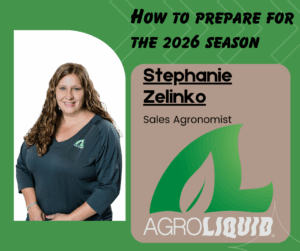
It’s easy to focus just on getting the crop out of the field. It’s the most exciting time of the year! However, the groundwork for a profitable next season starts now. By using the final weeks as an evaluation period, you can use this year’s crop to make better decisions for next time.
How can you build a better plan for the 2026 season? We spoke with AgroLiquid sales agronomist Stephanie Zelinko about what growers can do.
Why plan now
According to Stephanie, it’s important to start planning now, before harvest is over. Evaluating your existing crop at the end of the season is a great way to get started on the coming year’s crop. Walking fields now, as the crop is finishing up its lifecycle, allows you see where your nutrient program may have run short.
“Did you have enough nitrogen and potassium to finish the crop, or were deficiencies starting to show up?” Stephanie asked. “How do your corn ears look, and are your soybeans full pod to the top? Your crops communicate – all you have to do is watch. Then you take that information to help build a better program for next season.”
Pest damage and future influence
Growers need to take note about weeds, diseases, or insect damage that could influence decisions for next season, since a plant’s ability to handle stress impacts your final yield. By combining a pest management strategy with a nutrition program, you can help create a more resilient crop. Plus, planning ahead for threats like these helps you respond quickly if they do happen.
“Any stress will limit yield, and controlling pests will reduce the stress load on the crop,” Stephanie said. “From the nutrition side, having a healthy plant will help them through periods of stress. Potassium plays in key role in stress management, and foliar applications applied with your crop protection will help the plant recover quicker.”
The value of data
To get a complete picture, there is definite value in taking late-season plant tissue samples and soil samples. Soil, tissue and sap samples are all good ways to see how your soil and plant are doing and can help connect the dots once yield results come in. Looking over all this information can help improve outcomes for the next year. Once growers have data – notes, yield maps, soil tests – they can turn it into a plan. Since there is a lot of information, it’s helpful finding someone to put it all together.
“The more data you can get from the field the better decisions you can make,” Stephanie said.
Looking ahead: The biggest challenge for 2026
Based on what Stephanie is seeing in the fields and economic climate this year, she shared what change she thinks many growers will need to make for 2026.
“I think the biggest challenge this year and will continue into 2026 is the overall ag economy,” she said. “I think growers are doing a good job overall managing through this time. However, as we continue to see this in another season growers should be conscious on where they are cutting back. Growing a crop off of ‘banked’ nutrients can be a short-term solution, however, as the economic state continues this bank will need to be replenished.”
Before harvest, look at your crop and your data, set a budget, and work through that information so you can spend your dollars to best serve the crop and your farm. Here’s to a great harvest, and an even better kickoff to next season!

